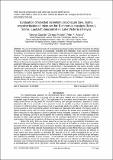Evaluation of selected Acremonium zonatum Saw. Gams. mycoherbicide-oil mixtures for Eichhornia crassipes (Mart.) Solms. Laubach) biocontrol in Lake Victoria (Kenya

View/
Publication Date
2017Author
Evaluation of selected Acremonium zonatum Saw. Gams. mycoherbicide-oil mixtures for Eichhornia crassipes (Mart.) Solms. Laubach) biocontrol in Lake Victoria (Kenya
Metadata
Show full item recordAbstract/
The use of microbial innoculum oil formulations has shown great promise for enhancing the efficacy
of fungal agents that show potential as insecticides, fungicides and herbicides. When used in mycoherbicide
formulation, oil encloses the moisture lost from the leaves, which provide the moist micro climate necessary for
infection. The innundative ability of this phytopathogen using three oil types (i.e. petroleum oil (mineral in
origin), corn oil (in vegetative tissue) and glycerol (occurring in animal tissue) having been confirmed, a new
study was initiated at the Maseno University glasshouse to evaluate their specific suitability in enhancing the
efficacy of Acremonium zonatum for the biocontrol of water hyacinth in Lake Victoria. A. zonatum was isolated
aseptically following standard procedures. Pure cultures obtained were mass produced on PDA. Spores were
then harvested after the surface of the cultures turned brown. A haemocytometer was used to prepare a stock
solution with 1x107
spores/ml. in sterile distilled water using Caprette’s method. Healthy water hyacinth plants
arranged in a RCBD within the glasshouse were inoculated with the mycoherbicide in the three selected oil
formulations. A control experiment was mounted using sterile distilled water. Disease score recording was
done three times at fourteen day intervals. Analysis of the results indicated that glycerol appeared to be the most
suitable oil formulation of A. zonatum as a mycoherbicide followed by corn oil. Petroleum oil emulsion showed
the least efficacy for the same purpose
Collections
- Department of Botany [232]
